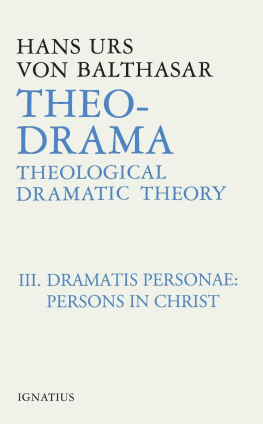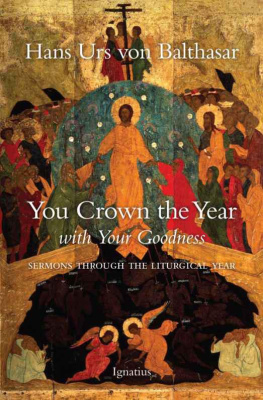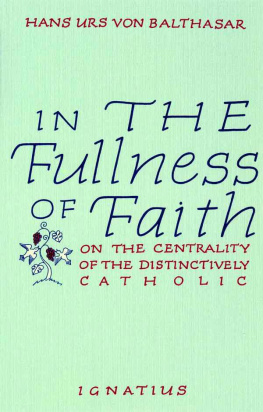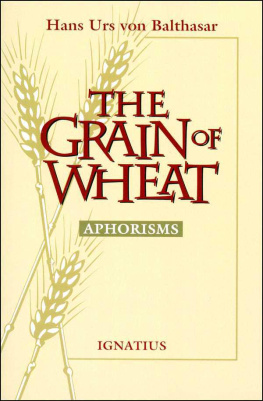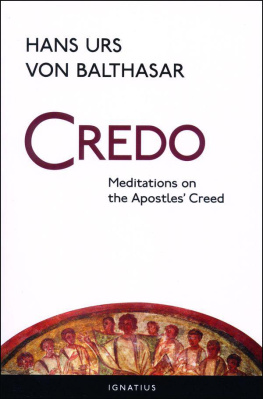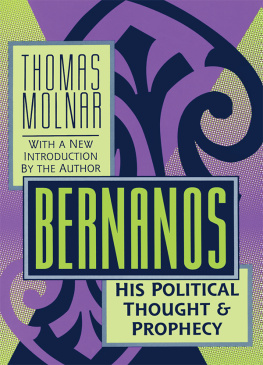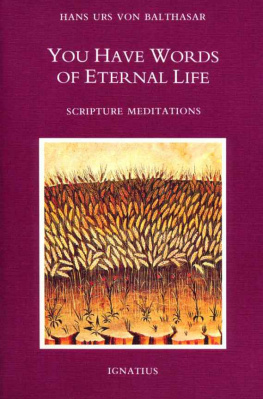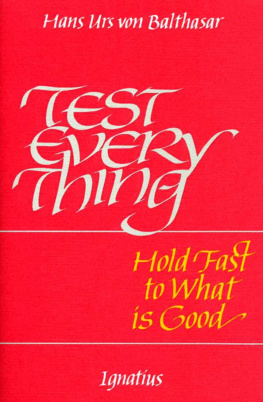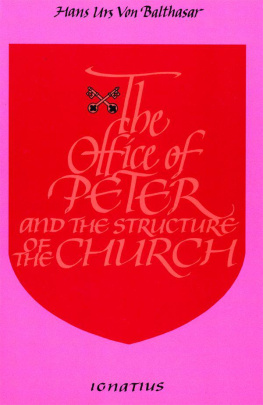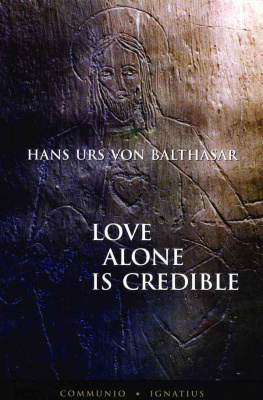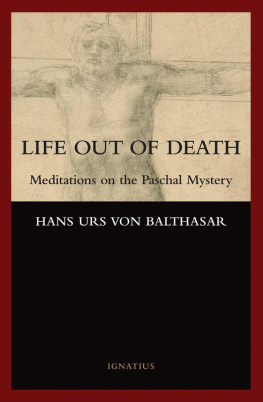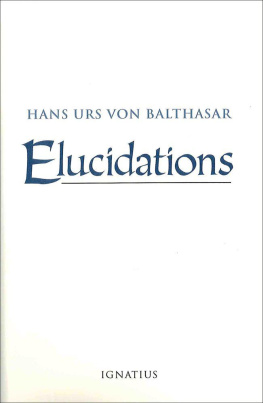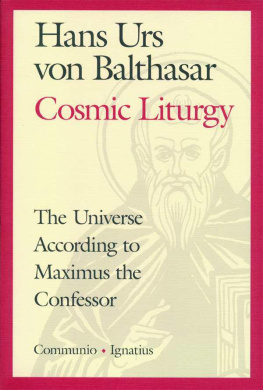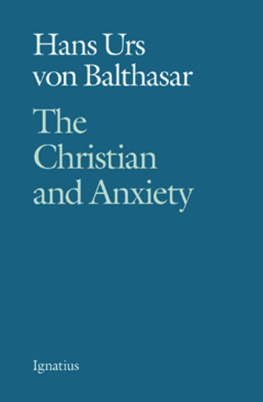BERNANOS
HANS URS VON BALTHASAR
BERNANOS:
AN ECCLESIAL
EXISTENCE
TRANSLATED FROM
THE GERMAN AND THE FRENCH
BY ERASMO LEIVA-MERIKAKIS
A COMMUNIO BOOK
IGNATIUS PRESS SAN FRANCISCO
Title of the German original:
Gelebte Kirche: Bernanos
third edition
1988 Johannes-Verlag, Einsiedeln, Trier
Cover by Roxanne Mei Lum
1996 Ignatius Press, San Francisco
All rights reserved
ISBN 978-089870-576-8
Library of Congress catalogue number 95-79888
Printed in the United States of America
TO LOSE ONES LIFE FOR ONES HONOR,
TO LOSE ONES HONOR FOR ONES SOUL.
Motto on an old Spanish noble house
CONTENTS
A CHRISTIAN AND A WRITER
1. The Measure of Man
2. Christian Boldness
3. Gentle Compassion
1. Youth
2. Maturity
3. From Primal Forest to Desert
1. Reason That Transcends
2. Prophetic Reason
3. Reason as Freedom
4. Catholic Reason
1. The Dream of Existence and Eternity
2. The Poets Dream and Reality
3. The Evil Dream and Sanctity
1. Calling
2. Pathos
3. The Object
4. The Idea of Literature
5. The Impossible Vocation
THE CHURCH: A PLACE FOR LIVING
1. Man
2. Nature
3. The World
1. The Priestly Office and Holiness
2. Obedience
3. Sacramentality
4. Transcendence and Mysticism
1. Sanctity
2. Childhood and Hope
3. Mediocrity and Scandal
4. The Imbecile
1. The Kingdom of Evil
2. Physicians of Souls
3. Two Sorts of Seer
4. The Battle of Confession
5. Damnation and Redemption
1. Death Agony as Boundary
2. Death Agony as Center
3. Death Agony as Communion
4. Communion as Night
5. I and Thou
CONTEMPORARY MAN
1. The Face of the Present
2. An Ethos of Honor
3. Between Revolutions
1. The Face of Christendom
2. Obedience and Responsibility
3. Blessed the Poor in Spirit!
TRANSLATORS NOTE
One aspect of the genius of Hans Urs von Balthasar is his knack for making the subject of his study come alive before the reader. The sterling theologian never hesitates to make himself the servant of his chosen theme, all the more so when his focus is on someone with the spiritual depth and creative stature of Georges Bernanos, surely the greatest Catholic creative writer of the twentieth century. The impression we receive as we follow von Balthasars patient unfolding of the thoughts, images, and characters that populate Bernanos universe is not so much of an analyst probing his inert material as of a sorcerer conjuring up intact the overpowering presence of a great-souled human being. Let the qualifier intactreferring to the comprehensiveness of treatment, the thoroughness of the exposition, and the absence of all interpretive violencesuffice for the moment in explaining the considerable length and occasional complexity of the pages that follow. Von Balthasar has here accomplished for Georges Bernanos what in another book he achieved for Karl Barth, author of the multivolume Church Dogmatics , and what he likewise did, in the smaller format of the monograph in the second and third volumes of The Glory of the Lord , for a significant number of great Christian poets and thinkers: the miracle of distilling without denaturing, of compressing without reducing, of interpreting without distorting.
The secret of von Balthasars miracle is in itself quite simple: judicious quoting of the primary source and careful juxtaposing of texts and commentary, in such a way that the selected passages are not so much proof-texts for theological theories as a tranquil forum from which Bernanos can speak to the reader with unhampered freedom. But the actual realization of such a simple formula also requires the intuitive brilliance unique to von Balthasar. And that is the essence of von Balthasars service to Bernanos: to have provided him with a space of contemplative leisure and a context within the total ecclesial Mystery of Christ out of which he can speak his mind in such a way that he can be clearly heard and genuinely understood. The Swiss theologian quotes the French novelist and cultural critic well and at length, so that not the least feature of the present volume lies in its being a thematic anthology of many of the best texts in Bernanos.
The English translator thus owes a great debt of gratitude to Maurice de Gandillac, whose French version of the present work Le Chrtien Bernanos (Paris: Editions du Seuil, 1956)proved an indispensable companion. It offered me on a silver platter, as it were, all of the passages from Bernanos in the French original. Given the very great space occupied in this book by Bernanos texts (I estimate a good 20 to 25 percent), it is highly doubtful whether a translation into English (or, indeed, any other language) could have been prepared from von Balthasars text alone, since here Bernanos of course appears in German translation. De Gandillac has already accomplished for all future translators the huge labor of compiling within the covers of one book the original of all texts quoted by von Balthasar.
In addition, de Gandillac has put many quotations and references in context by detailing situations, persons, and cultural movements. As well, he has identified the correspondence by date and recipient where von Balthasar has a mere bibliographical symbol, and he has at times given a fuller form of some quotations that von Balthasar gives more skeletally. Finally, I have followed de Gandillacs lead in breaking up the massive paragraphs of the German text into more digestible portions.
I am thankful to David Schindler and David Spesia, of Communio Catholic International Review , for having insisted that I undertake a project that bolstered my personal life in surprising ways by putting me for nine months in the daily company of two extraordinary hearts and minds. Stanley Nel, Dean of the College of Arts and Sciences of the University of San Francisco, made this translation and other projects possible by granting me a years leave of absence from my teaching post.
As always I am humbly grateful to my wife, Mireya Letayf, for her warm interest and day-to-day encouragement in seeing this translation through to the end. Two friends, Michael Torre and Patrick Carey, provided a crucial stimulus by often requesting sample passages of my work as I produced it. In many ways, then, the book belongs to these three.
E. L.-M.
Chihuahua, Mexico
11 June 1995
Solemnity of the Holy Trinity
BIBLIOGRAPHICAL REFERENCES
IN THE FOOTNOTES
We here give the date of first publication, followed by the publisher and date of the edition referenced. Square brackets enclose the abbreviated title of the work.
Finally, we give the literal English translation of the works titles as used in the present volume.
I. WORKS OF FICTION
AND HAGIOGRAPHY
Madame Dargent (1922). Plon, 1955.
[ Madame Dargent ]
Madame Dargent
Sous le soleil de Satan (1926). Plon, 1926.
[Soleil]
Under Satans Sun
Saint Dominique (1926). Gallimard, 1939.
[Dominique]
Saint Dominic
LImposture (1927 ). Plon, 1929.
[Imposture]
The Imposture
La Joie (1928). Plon, 1929.
[ Joie]
Joy
Une Nuit (1928). Plon, 1955.
[Nuit]
A Night
Dialogue dombres (1928). Plon, 1955.
[ Dialogue dombres]
Conversation among Shadows
Jeanne relapse et sainte (1929). Plon, 1934.
[Jeanne]
Joan, Heretic and Saint
Un Crime (1935). Plon, 1935.
[Crime]
A Crime
Journal dun cure de campagne (1936). Plon, 1936.
[Cur]
Diary of a Country Priest
Nouvelle Histoire de Mouchette (1937). Plon, 1937.
[Mouchette]
Mouchettes New Story
Next page


